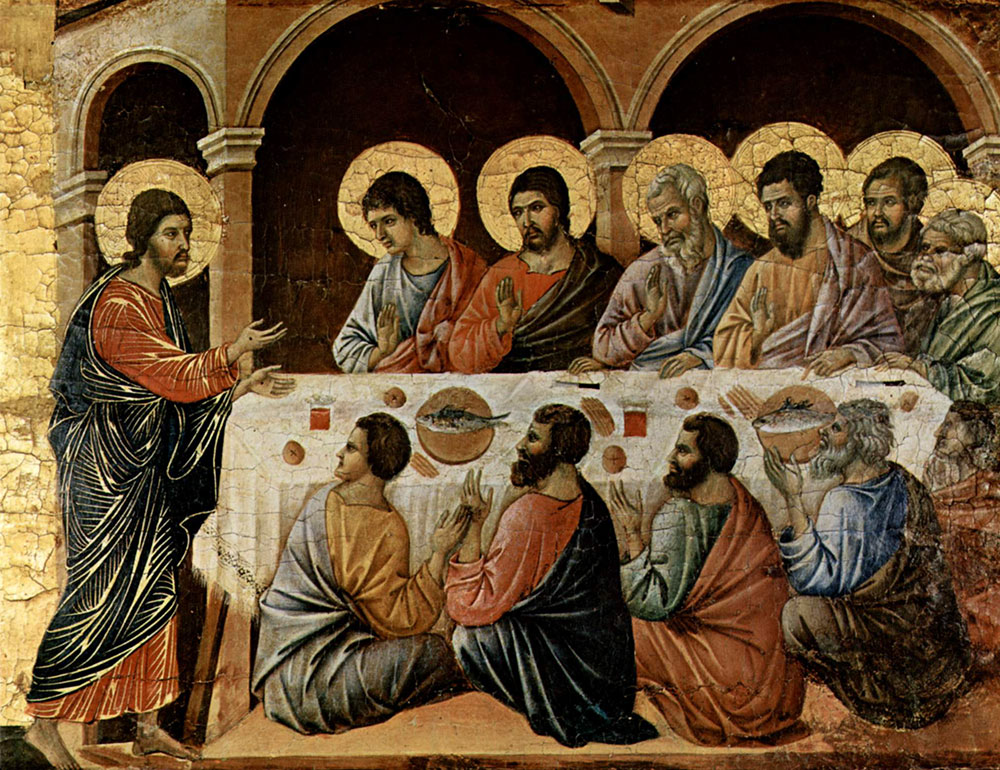Jesus’ Farewell Discourse, as recorded in John 14 to 17, is full of images of who Jesus is. These four chapters present Jesus as a shepherd; a gate; and the way, the truth and the life.
But this passage is about more than who Jesus is. It is also profoundly about what Jesus wants. We see this uniquely in Jesus’ High Priestly Prayer in John 17, as he prays for his present and future followers.
The church has historically paid careful attention to how Jesus teaches us to pray; many recite the Lord’s Prayer daily or weekly. But it’s equally worth paying attention when Jesus himself prays. He prays for two things:
- Protection.
- That his followers would be one.
He doesn’t pray that his followers would be right, successful or even influential. He prays that they would be one. Nine times in John 17 alone, we find the word “one.” Apparently it matters a great deal to Jesus that his followers be one.
How have we been doing with this?
One section of Willard Swartley’s commentary on John 17 (John: Believers Church Bible Commentary from Herald Press) begins with this lament: “Church history is very disappointing.”
We could be forgiven for laughing out loud . . . or weeping. This seems like the height of understatement. Jesus’ last words before going the way of the cross for the salvation of the world were an impassioned prayer for the oneness and unity of his followers, yet at times it seems that his church has spent the next two or so millennia fighting and fragmenting.
Since the Protestant Reformation, we have become particularly good at this. Depending on which website you consult, who decides what counts as “Christian” and what doesn’t, and who’s doing the math, there could be as many as 41,000 different Christian denominations in the world right now. That’s 40,999 more than one, for those keeping score.
Can we come to any other conclusion than that we have utterly, completely and depressingly failed to be the answer to Jesus’ prayer?
But it goes far beyond labels and denominations. We’re getting better at working together across denominational boundaries that were once rigid and impermeable. Mennonite churches participate in numerous initiatives with Anglicans, Presbyterians, Roman Catholics, Lutherans, Baptists and others.
We may worship in different ways, we may have different understandings of certain aspects of theology or biblical interpretation, and we may have different histories, but in working and praying together we give voice to the conviction that we are one in Christ.
Considering that a few hundred years ago people were killing each other over the differences that these denominations were founded on, this represents real progress! But our lack of unity now seems to bleed across denominational lines and has become concentrated on social issues, politics and theology.
Let’s narrow our gaze and think just about our own Mennonite denomination. Are we one? Many would say no, we are not.
Whether it is our views about human sexuality, as highlighted in the Being a Faithful Church process; our understandings of the implications of religious pluralism and the scope of salvation; our attitudes toward human-induced climate change; our disputes about worship styles; our understandings of peace and justice, and how these are to be attained, and what they require of us; our ideas about how best to move forward as a denomination (the Mennonite Church Canada Future Directions Task Force is wrestling with this now); or others, we are clearly not of one mind.
It is rare that I attend a provincial or national Mennonite gathering, or open the pages of Canadian Mennonite, and not hear or read some expression of anxiety about the future of our denomination based on a lack of theological unity on one or more of these issues.
Mennonites have always run into a bit of a conundrum when it comes to unity. We’ve obviously never had a centralized authority structure like a “Mennonite pope” or anything like that. This would run completely counter to our convictions about the “priesthood of all believers” and the imperative for all believers to interpret Scripture in community under the guidance of the Holy Spirit.
The problem is, what happens when we don’t agree? Who decides then?
In the past, unity was perhaps easier to attain when Mennonites lived in tight, close-knit communities with strong—sometimes toxic—structures of authority in churches and families.
But we don’t live in this kind of world anymore. We live in a culture that is increasingly characterized by individualism, consumerism and countless other nasty “isms,” and we increasingly understand ourselves in these terms. We “shop” for churches that meet our needs and preferences, that suit our theological tastes, that reflect our political views or perspectives on controversial social issues, or that reflect our preferred approach to biblical interpretation. Very often, the sovereign self is the centre around which everything else orbits.
So, given the realities of 21st-century western culture and a church that is, in many ways and many places in the postmodern West, in at least a numerical decline; that people increasingly view religion and church as kind of privatized options for those who are “into” spiritual things; that we always interpret everything, including the Bible, through the lens of our own histories and preferences, our own hopes and fears . . . how will we ever attain anything like the oneness that Jesus prayed for?
Re-examining the nature of unity
First of all, unity is not synonymous with uniformity. Among the dictionary defi-nitions for “unity” are:
- A condition of harmony, accord.
- Continuity without deviation or change (as in purpose or action).
- Totality of related parts: an entity that is a complex or systematic whole.
By contrast, “uniformity” is defined as “the quality or state of being the same, uniform or identical.”
When we lament the lack of unity in the church, as we often do, we are, in fact, expressing our frustration that Christian denominations, our own Mennonite denomination or people in our local church, are not uniform. Which is to say, we are frustrated that not everyone thinks or acts like us.
American sociologist Christena Cleveland has recently written a book called Disunity in Christ: Uncovering the Hidden Things That Keep Us Apart. After pointing to countless experiments and data, she comes to the not very shocking—or flattering—conclusions that, as human beings:
- We tend to like being right.
- We tend to like associating mostly with people who think like we do.
Put these two realities together, combine them with the inevitable anxiety that is produced when important existential, moral and social issues are on the table, and you have a recipe for trouble.
But Cleveland also says that we shouldn’t expect uniformity. We shouldn’t expect the body of Christ to be a collection of same-thinking, same-acting, same-looking automatons. This would, in fact, be spectacularly boring.
The church has always been characterized by differences of opinion. We see this even in the New Testament, with Peter and Paul having disagreements—sharp ones, even—about the nature of their mission (Galatians 2:11-14). We see it implicitly in the gradual, meandering trail that Jewish Christians traversed toward acceptance of the Gentiles and the stuttering process by which some people relinquished elements of the Jewish law as necessary for salvation.
We have seen this throughout church history. Not a word of theology or doctrine would have ever been written if the life of faith was a one-size-fits-all-for-all-time blueprint laid clearly out in Scripture. At every stage of the church’s history it has been necessary to think, wrestle, argue, disagree and seek to persuade others. That’s what it means to be in community and to be faithful to the way of Jesus in different social, historical and cultural contexts.
Oneness does not—cannot—require uniformity. Indeed, this is not healthy, or even possible, in a world where all of us only see in part, not in full.
Love and oneness
If we grant that unity, not uniformity, is what Jesus wants and has always wanted for his church, where does our unity lie? What is it that makes us one?
This is one of those cases where the stock “Sunday school answer” is actually the best, deepest and truest answer we could ever hope to give.
The answer is, “Jesus and our participation in the love he shares with the Father.” Jesus himself says this in John 17:23: “I in them and you in me, that they may become completely one, so that the world may know that you have sent me and have loved them even as you have loved me.”
If we back up just two chapters, we read these words: “This is my commandment, that you love one another as I have loved you. No one has greater love than this, to lay down one’s life for one’s friends. You are my friends if you do what I command you” (John 15:12-13).
So oneness is based on love shared between the Father and Son, love that is meant to spill out into and among the lives of Jesus’ followers. The question then becomes, “So what does it mean to love one another?”
I regularly lament the fact that I Corinthians 13 is viewed by many as a wedding text about romantic love, because it isn’t. At least not primarily. It’s a manifesto for life together as the church.
I Corinthians 13:4-8a is among the most well-known passages in all of Scripture: “Love is patient; love is kind; love is not envious or boastful or arrogant or rude. It does not insist on its own way; it is not irritable or resentful; it does not rejoice in wrongdoing, but rejoices in the truth. It bears all things, believes all things, hopes all things, endures all things. Love never ends.”
I propose an experiment, then, as we think about love and oneness, and unity and uniformity, in the context of a church that struggles so mightily to agree.
Think of the Christian or group of Christians whose views on controversial issues you find most distasteful, difficult to understand, frustrating, incomprehensibly stupid or even offensive.
As a sister and brother in Christ, my posture towards this person or this group must always be characterized by patience . . . kindness . . . hope . . . endurance.
And when I am speaking about, or interacting with, these sisters or brothers in Christ with whom I disagree, sometimes profoundly, I must never be arrogant . . . rude . . . envious . . . boastful . . . resentful. I must not insist on my own way. I must not rejoice in wrongdoing, but in the truth. I must bear all things . . . even errors! And this posture of love towards them must not change, because love never ends.
No matter how much I might disagree with them, I am to love them in this way for the simple reason that we are sisters and brothers in Jesus Christ, because each of us in our own ways, with our own errors and blind spots, our sins and struggles, our own triumphs and victo-ries, our own hopes and fears, is clinging to Jesus Christ. If we don’t love like this, Paul says, we are nothing more than a noisy, useless gong, because it doesn’t matter how right we are or how wise we are if we fail to love like this.
But when we do love one another like this, Jesus promises that the world will begin to see and to know what God truly looks like, what love truly looks like, and to recognize that they, too, are invited into this love.
May God help us to be one.
Adapted from a sermon Ryan Dueck, pastor of Lethbridge (Alta.) Mennonite Church, preached there on June 1, 2014, the seventh Sunday of Easter. He writes online at www.ryandueck.com.
–Posted Sept. 10, 2014









Leave a Reply
You must be logged in to post a comment.